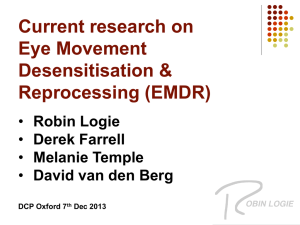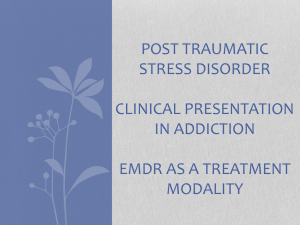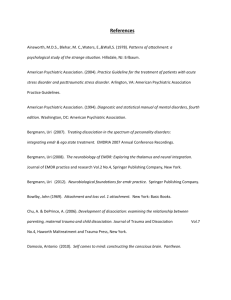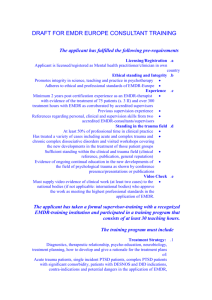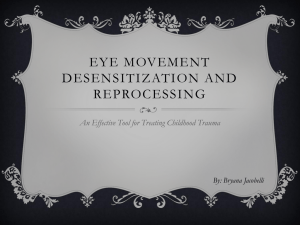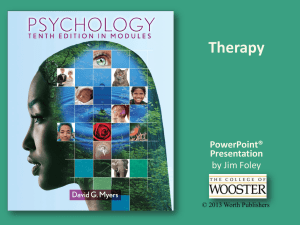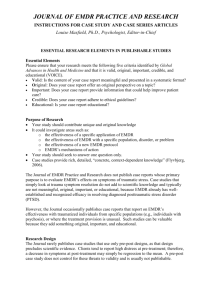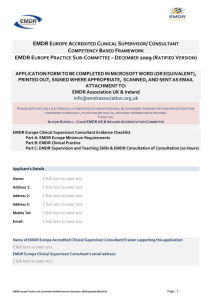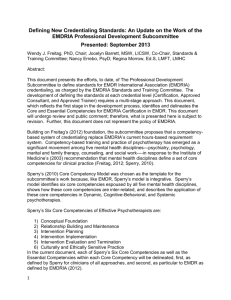REVIEW FORM For Journal of EMDR Practice and Research
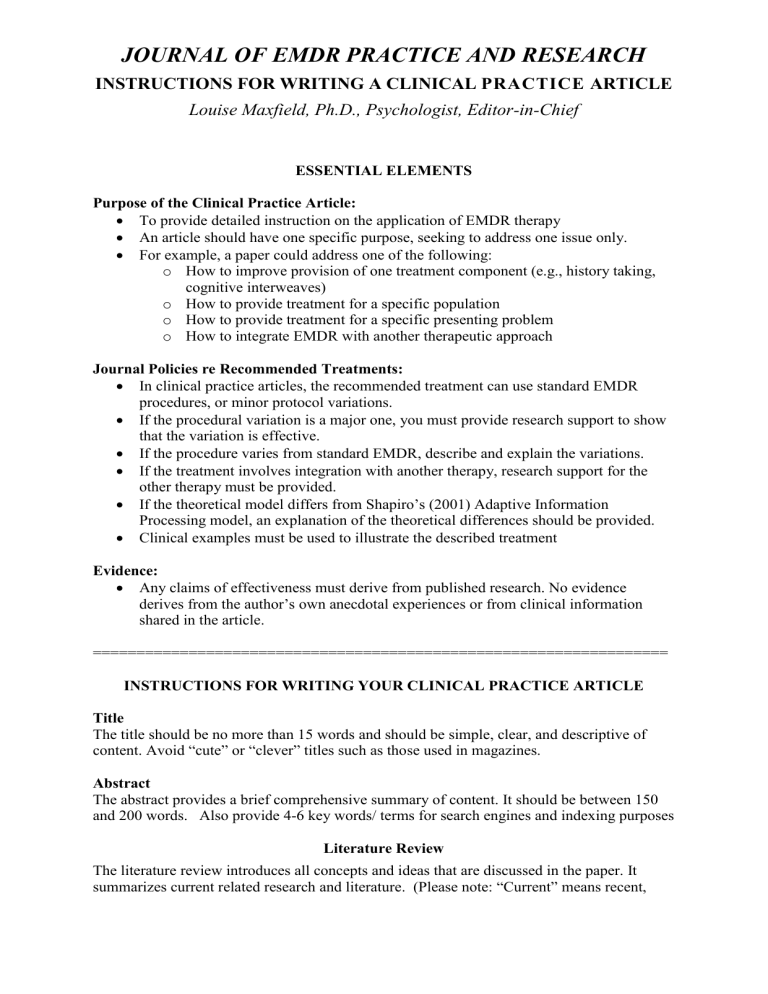
JOURNAL OF EMDR PRACTICE AND RESEARCH
INSTRUCTIONS FOR WRITING A CLINICAL PRACTICE ARTICLE
Louise Maxfield, Ph.D., Psychologist, Editor-in-Chief
ESSENTIAL ELEMENTS
Purpose of the Clinical Practice Article:
To provide detailed instruction on the application of EMDR therapy
An article should have one specific purpose, seeking to address one issue only.
For example, a paper could address one of the following: o How to improve provision of one treatment component (e.g., history taking, cognitive interweaves) o How to provide treatment for a specific population o How to provide treatment for a specific presenting problem o How to integrate EMDR with another therapeutic approach
Journal Policies re Recommended Treatments:
In clinical practice articles, the recommended treatment can use standard EMDR procedures, or minor protocol variations.
If the procedural variation is a major one, you must provide research support to show that the variation is effective.
If the procedure varies from standard EMDR, describe and explain the variations.
If the treatment involves integration with another therapy, research support for the other therapy must be provided.
If the theoretical model differs from Shapiro’s (2001) Adaptive Information
Processing model, an explanation of the theoretical differences should be provided.
Clinical examples must be used to illustrate the described treatment
Evidence:
Any claims of effectiveness must derive from published research. No evidence derives from the author’s own anecdotal experiences or from clinical information shared in the article.
==================================================================
INSTRUCTIONS FOR WRITING YOUR CLINICAL PRACTICE ARTICLE
Title
The title should be no more than 15 words and should be simple, clear, and descriptive of content. Avoid “cute” or “clever” titles such as those used in magazines.
Abstract
The abstract provides a brief comprehensive summary of content. It should be between 150 and 200 words. Also provide 4-6 key words/ terms for search engines and indexing purposes
Literature Review
The literature review introduces all concepts and ideas that are discussed in the paper. It summarizes current related research and literature. (Please note: “Current” means recent,
Instructions for Clinical Practice Articles p. 2 within the last 10 years, since 2005, except for seminal papers/books). All core concepts being discussed in the paper must be introduced here. Do not introduce new ideas in the
Discussion. It is expected that you will have about 25 references. Please ensure that all the following are included in this section and please use headings for each section of the literature review. There should be at least one heading on each manuscript page.
Briefly introduce the purpose and nature of your article in the first paragraph
Introduce the problem/issue (e.g., chronic depression) or if another treatment is being integrated with EMDR, introduce that treatment (e.g., hypnosis)
Explain/define unique terms, specific language, diagnoses, etc.
Describe common and current ways that problem/ issue is treated/addressed or if another treatment is being integrated with EMDR, describe that treatment and explain how it is commonly used
Explain the case conceptualization that leads to your recommendation of the described procedures, so that the reader will be able to readily identify those cases/situations in which your treatment is applicable
Assume the reader of your article has no prior knowledge about EMDR. Introduce
EMDR, stating that it has established efficacy for PTSD with appropriate citations. o Provide a brief description of EMDR therapy (enough so that a naïve uninformed reader can understand the paper) o Add a brief description of AIP model if relevant (e.g., if AIP is referred to in the Case Description/s or theoretical discussions) o Introduce any EMDR term or concept that is referred to in the Case
Description/s (e.g., SUD, VOC, interweave, NC, PC, installation).
Summarize related EMDR publications.
Focus your summary on the problem area being investigated in your paper.
Do not include concepts that are not directly related to your procedures. For example, do not include hypotheses about EMDR’s mechanisms of action or neurobiological explanations unless these are necessary and directly related to your instructions for the provision of the recommended treatment.
Highlight any unique factors relevant to your topic.
All core concepts being discussed in the paper must be introduced here. Do not introduce new ideas in the Discussion.
Description of the Treatment
Please see above, “Journal Policies re Recommended Treatments” in the Essential
Elements section
If you are proposing protocol variations, provide a summary or outline of the recommended treatment so that readers can understand the broad picture of what is proposed
If your procedure uses a major variation in EMDR procedures, provide research support for the modification.
Description of the Application with Clinical Examples
Your recommended procedures should be described with sufficient detail so that they can be replicated by readers.
Please follow a clear consistent strategy in your organization. Some options are: o organize instruction in a sequential fashion (e.g., phase one, phase two, etc.)
Instructions for Clinical Practice Articles p. 3 o organize in a temporal fashion (e.g., first, second, etc.) o organize by problem areas o organize by using detailed case examples (e.g., case one, case two)
Use clinical examples throughout to illustrate your teaching points. Clinical material should not contain more information about the client than is needed for the example.
Make sure you preserve patient confidentiality and that clients cannot be identified.
Discussion
The Discussion section summarizes, evaluates, interprets, and explains the treatment application. Include the following, if relevant and appropriate:
Expand on concepts and ideas that were already introduced in the Literature Review
Discuss theoretical aspects
Discuss practical consequences
Link to prior publications, research
Describe the limitations of your proposal
Explain when and how to use the recommended treatment.
Explain indications and contra-indications, describing who might benefit and who should not be treated with the proposed treatment.
Recommend future research with concrete ideas and practical designs to test proposed treatment.
EXAMPLES OF CLINICAL INSTRUCTION PAPERS IN JEMDR
Dworkin, M., & Errebo, N. (2010). Rupture and repair in the EMDR client/clinician relationship: Now moments and moments of meeting . Journal of EMDR Practice and
Research, 4(3), 113-123.
Harford, P. M. (2010). The integrative use of EMDR and clinical hypnosis in the treatment of adults abused as children . Journal of EMDR Practice and Research, 4 (2), 60-75.
Logie, R. D. J., & De Jongh, A. (2014). The "flashforward procedure": Confronting catastrophe.
Journal of EMDR Practice and Research, 8 (1), 25-32.
Martin, K. M. (2012). How to use Fraser's dissociative table technique to access and work with emotional parts of the personality. Journal of EMDR Practice and
Research, 6(4), 179-186.
Mosquera, D., Leeds, A. M., & Gonzalez, A. (2014). Application of EMDR Therapy for
Borderline Personality Disorder. Journal of EMDR Practice and Research, 8, ( 2), 74-
89.
Reicherzer, S. (2011). Eye movement desensitization and reprocessing in counseling a male couple. Journal of EMDR Practice and Research, 5( 3), 111-120.
Ross, C. A. (2015). When to suspect and how to diagnose dissociative identity disorder.
Journal of EMDR Practice and Research,9 (2), 114-120.
Solomon, R. M., & Rando, T. (2008). Utilization of EMDR in the treatment of grief and mourning . Journal of EMDR Practice and Research, 1 (2), 109-117. van der Hart, O., Groenendijk, M., Gonzalez, A., Mosquera, D., & Solomon, R. (2013).
Dissociation of the personality and EMDR therapy in complex trauma-related disorders: Applications in the stabilization phase.
Journal of EMDR Practice and
Research, 7 (2), 81-94.
Instructions for Clinical Practice Articles p. 4
STYLE
1.
Manuscripts must be professionally prepared in accordance with the Publication Manual of the American Psychological Association , 6th edition, 2009. http://www.apastyle.org/manual/whats-new.aspx
A sample paper can be viewed at: http://flash1r.apa.org/apastyle/basics/data/resources/sample-papers.pdf
2.
Page size should be “Letter” size (8.5 x 11 inches, 21.59 x 27.94 cm), with a one inch
(2.54 cm) margin on all sides.
3.
Font is Times Roman, size 12. Manuscripts are double-spaced, about 20-35 pages in length. Double-space everything, including references, quotations, tables, and figures.
4.
Format with a left margin alignment (not justified). Each paragraph should have a first line-indent. There should be no spaces between paragraphs.
5.
The first page must include authors’ names, affiliations, and full contact information
(address, phone, fax, and e-mail). This information should not be included elsewhere in the manuscript, to ensure blind review.
6.
The second page contains only the title of the paper, abstract, and key words. The title should be no more than 15 words. Abstracts are 150-200 words. List 4 to 6 key words/terms below the abstract.
7.
The header on each page should contain the running head for the manuscript, and the page number. Number manuscript pages consecutively in the header on each page.
8.
If possible, figures should be black, white, and grey scale. Photos and line art figures should be sent as tiff (300ppi) or eps (800ppi) or jpeg files. All illustrations (i.e., photographs, drawings, diagrams, and charts) should be numbered (with Arabic numerals) and referred to by number in the text (e.g., Figure 1). The captions for illustrations should be typed on a separate sheet of paper; this page and the figures should be placed after the References at the end of the manuscript.
9.
Tables should be numbered (with Arabic numerals) and referred to by number in the text
(e.g., Table 1). Each table should be typed on a separate sheet of paper, and placed after the References at the end of the manuscript. Center the title above the table; the title should be short. Type explanatory notes below the table.
10.
References use a hanging indent and are formatted according to APA style. Instructions are accessible in many online sites. (Also, see APA sample paper in #1 above.)
11.
Please use APA style headings for sections and subsections, with at least one heading per manuscript page to guide the reader and provide organization. Headings should be clear and descriptive – not the clever quotations sometimes used in book chapters.
